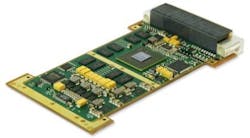Guest viewpoint, 10 Aug. 2011. Courtney Howard's article entitled "Harnessing high-performance computing" that ran in the July 2011 issue of Military & Aerospace Electronics was further proof that, for developers of embedded computing applications for military and aerospace applications, high performance computing (HPC) is a hot topic. That's no surprise: military and aerospace applications have long been voracious devourers of as much computing capability as they can find.
HPC in the commercial world is already well established, and the technology is evolving to extract maximum advantage from many-core and multicore processors as well as multi-processor blades in applications where a high degree of potential parallelism exists.
The very highest-performance computers in the world use clusters of thousands of the latest multicore central processing units (CPUs) from Intel along with thousands of NVIDIA's many-core GPUs, often tightly coupled via Infiniband and 10 Gigabit Ethernet remote DMA-enabled (RDMA) switched fabric networks with robust, high-performance driver support under Linux and Windows operating systems.
Commercial interest and application is also driving the development of an infrastructure and ecosystem of supporting hardware, software, and middleware, reducing the need to develop complex, expensive proprietary solutions, and further enhancing the attraction of HPC.
For military and aerospace systems designers, it's all good news: not only is the massive investment in HPC in the commercial world driving technology and performance developments at a spectacular rate, but it also is doing so using the COTS principles that have become fundamental to embedded computing in military applications. The military and aerospace world is taking advantage of those developments.
Attracting substantial attention is general-purpose graphics processing unit (GPGPU) technology -- applying the inherent massively parallel architecture of graphics processors to general-purpose computing tasks. GE Intelligent Platforms in Charlottesville, Va., announced the GRA111 high-performance graphics board in November 2009, following the signing of a strategic agreement with NVIDIA, the market leader in GPU technology.
The agreement gives GE not only direct access to silicon but also the knowledge to implement it for military and aerospace applications, as well as insight into NVIDIA's roadmap. Since November 2009, GE has announced several high performance computing platforms based on NVIDIA's CUDA architecture -- notably the 6U OpenVPX NPN240 dual 96-core GT215 GPU multiprocessor and the 6U OpenVPX IPN250, which combines the GT215 GPU with an Intel Core2 Duo processor.
In a laptop computer, the GPU typically will be configured via an MXM (Mobile PCI Express Module). This is akin to what a military and aerospace systems designer would probably think of as a PMC or XMC containing some specific functionality mounted on a host board, rather than integrating the functionality directly on the host board. In the case of laptops, this approach allows manufacturers to implement alternative GPUs, or new generations of a GPU, without redesigning the host board.
The same, however, does not lend itself to the rigors of military computing. It may work well in benign environments, but it is unsuitable for rugged systems. It is in this area that GE's relationship with NVIDIA has proved especially beneficial. Access to in-depth NVIDIA expertise has enabled GE to implement GPU silicon on fully rugged embedded computers designed for the most demanding environments, and that meet standards such as AS9100, IPC 610 Class 3, and MIL-STD-810.
But 'rugged' involves more than resistance to shock, vibration, and temperature extremes. Another area in which military and aerospace customers differ from their commercial counterparts is in performance per Watt, rather than absolute performance. In a physically constrained environment, heat dissipation is difficult, yet absolutely vital to guarantee reliability in a mission-critical environment.
Governing the maximum performance of the system is the ability to remove heat from the processing units. That set of constraints has given rise to the notion of a solution's size, weight, and power (SWaP) characteristics. Designing the most power-hungry silicon down onto the host board provides the best possible opportunity to design heat management systems to remove the heat, and keep the processors crunching numbers at maximum performance, thus optimizing SWaP.
GPGPU technology is being evaluated and fielded in military and aerospace systems. One radar application, for example, shows a performance increase of 15x compared with more traditional approaches. Still, in an emerging market, it is important to realize that not all GPGPU platforms targeted at the military and aerospace market are created equal.
In the excitement about the technology, it's also important that program managers apply the same kind of selection criteria as they would for any other prospective solution, such as determining the nature of the extended product roadmap and the availability of long term programs to support multi-year -- perhaps multi-decade -- deployments. As GPGPU technology enters the military and aerospace mainstream -- as it surely will -- those considerations will, inevitably, become second nature.
Simon Collins is product manager at GE Intelligent Platforms, a specialist in rugged embedded computing solutions for aerospace and defense applications. For more information contact GE Intelligent Platforms online at www.ge-ip.com.
Related stories
-- 6U VPX single-board computer with NVIDIA graphics processing introduced by GE;
-- Rugged 2nd Generation Intel Core-based 3U VPX CPU board with NVIDIA CUDA graphics introduced by GE; and
-- GE Intelligent Platforms to introduce 2nd Generation Intel Core i7-based embedded computers.




